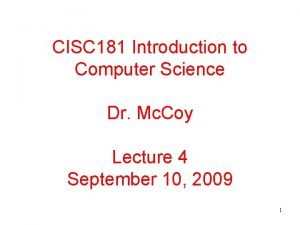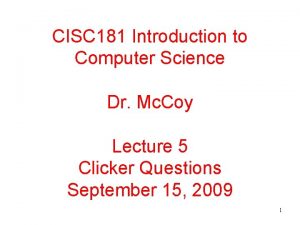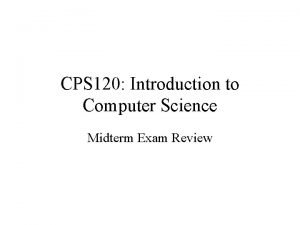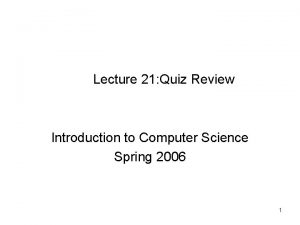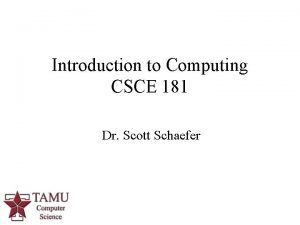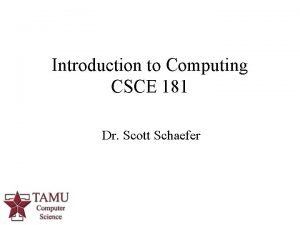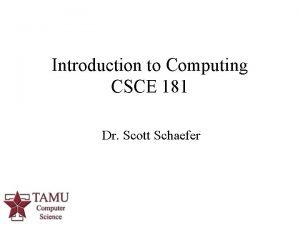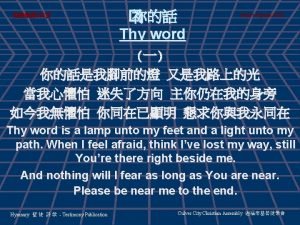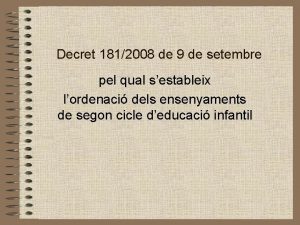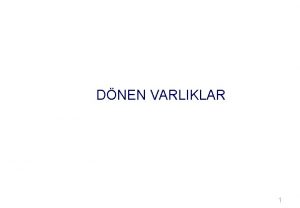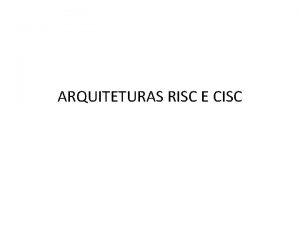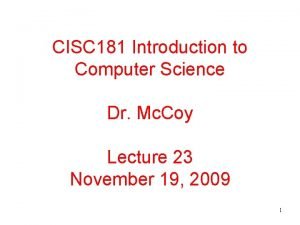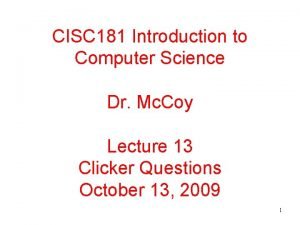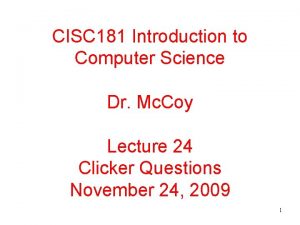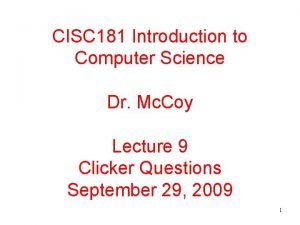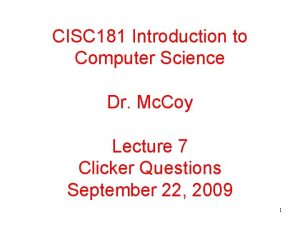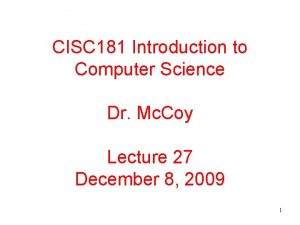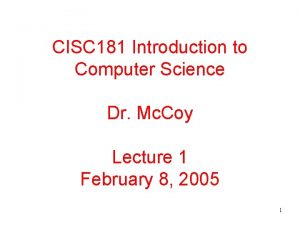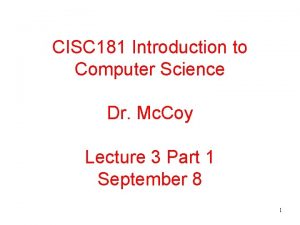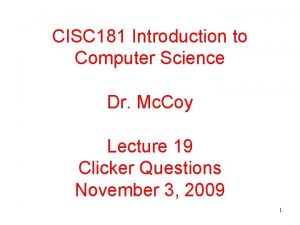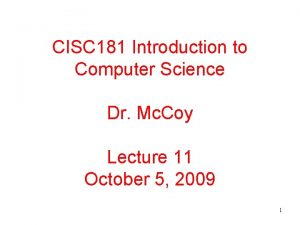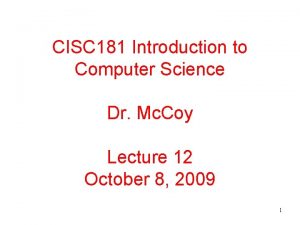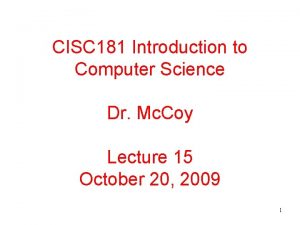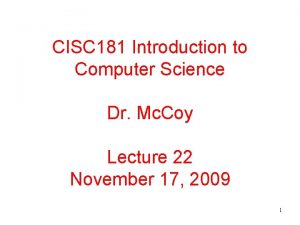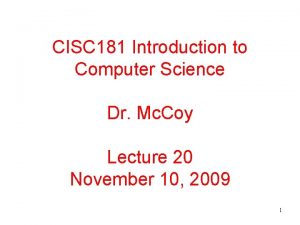CISC 181 Introduction to Computer Science Dr Mc



![Strings in Character Arrays • An alternative: char name[ ] = {‘J’, ‘a’, ‘n’, Strings in Character Arrays • An alternative: char name[ ] = {‘J’, ‘a’, ‘n’,](https://slidetodoc.com/presentation_image_h/288b92a32979af4b96f1c16bdb483a76/image-4.jpg)













![• • • A[0] = 1 A[1] = 2 A[2] = 4 A[3] • • • A[0] = 1 A[1] = 2 A[2] = 4 A[3]](https://slidetodoc.com/presentation_image_h/288b92a32979af4b96f1c16bdb483a76/image-18.jpg)



- Slides: 21

CISC 181 Introduction to Computer Science Dr. Mc. Coy Lecture 13 October 13, 2009 1

Repeated Slides • Some of the following slides are repeated from lecture 8 – character strings/character arrays 2

Storing Strings in Character Arrays • Character arrays may be initialized using a string literal: Char name[ ] = “Jane”; Initializes the char array “name” to hold the individual characters J-a-n-e plus a special string termination character called the null character writte ‘�’ So, name is a 5 character array. 3
![Strings in Character Arrays An alternative char name J a n Strings in Character Arrays • An alternative: char name[ ] = {‘J’, ‘a’, ‘n’,](https://slidetodoc.com/presentation_image_h/288b92a32979af4b96f1c16bdb483a76/image-4.jpg)
Strings in Character Arrays • An alternative: char name[ ] = {‘J’, ‘a’, ‘n’, ‘e’, ‘�’}; • Common mistake – when using a char array to hold strings, forgetting to leave the extra spot for the null termination character. 4

5 4. 4 Examples Using Arrays • Strings (more in ch. 5) KFM – note Ch 9 in Savitch – Arrays of characters – All strings end with null ('�') – Examples • char string 1[] = "hello"; – Null character implicitly added – string 1 has 6 elements • char string 1[] = { 'h', 'e', 'l', 'o', '�’ }; – Subscripting is the same String 1[ 0 ] is 'h' string 1[ 2 ] is 'l' 2003 Prentice Hall, Inc. All rights reserved.

Reading Character Strings • Character arrays input and output are straightforward. Can read a character string directly from the keyboard: char last_name[20]; cin >> last_name; NOTE: no indication last_name is an array in the input statement! NOTE: the read-in string must be at most 19 characters long else will have problems! • Character array output: cout << last_name; 6

7 4. 4 Examples Using Arrays • Input from keyboard char string 2[ 10 ]; cin >> string 2; – Puts user input in string • Stops at first whitespace character • Adds null character – If too much text entered, data written beyond array • We want to avoid this (section 5. 12 explains how) • Printing strings – cout << string 2 << endl; • Does not work for other array types – Characters printed until null found 2003 Prentice Hall, Inc. All rights reserved.

1 2 3 // Fig. 4_12: fig 04_12. cpp // Treating character arrays as strings. #include <iostream> 4 5 6 7 using std: : cout; using std: : cin; using std: : endl; 8 9 10 11 12 int main() { char string 1[ 20 ], char string 2[] = "string literal"; // reserves 15 characters Outline fig 04_12. cpp (1 of 2) Two different ways to declare strings. string 2 is initialized, and its size // determined reserves 20 characters. automatically Examples of reading strings fromstring 2 the keyboard and from user into array the string "helloprinting there": " ; out. them 13 14 15 16 // read string cout << "Enter cin >> string 1; 17 18 19 20 // output strings cout << "string 1 is: " << string 1 << "nstring 2 is: " << string 2; 21 22 cout << "nstring 1 with spaces between characters is: n" ; // reads "hello" [space terminates input] 23 2003 Prentice Hall, Inc. All rights reserved. 8

24 25 26 // output characters until null character is reached for ( int i = 0; string 1[ i ] != '�'; i++ ) cout << string 1[ i ] << ' '; 27 28 29 cin >> string 1; // reads "there" string cout << "nstring 1 is: " << string 1 << endl; 30 31 return 0; 32 33 // indicates successful Outline Can access the characters in a fig 04_12. cpp using array notation. (2 of 2) The loop ends when the null character is found. fig 04_12. cpp termination output (1 of 1) } // end main Enter the string "hello there": hello there string 1 is: hello string 2 is: string literal string 1 with spaces between characters is: h e l l o string 1 is: there 2003 Prentice Hall, Inc. All rights reserved. 9

Some recursive functions with arrays • From D&D 4. 37 – Printing a string backwards. • Write a recursive function string. Reverse that takes a character array containing a string as an argument, prints the string backwards, and returns nothing. The function should stop processing and return when the terminating null character is encountered. 10

Palindromes (D&D 4. 32) • A pelindrome is a string that is spelled the same way forwards and backwards. Some examples of palindromes are “radar”, “able was I ere I saw elba” (if blanks are ignored), “billib”, and “a man a plan a canal panama” (if blanks are ignored). 11

• Write a recursive function test. Palindrome that returns true if the string stored in the array is a palindrome, and false otherwise. • The function should take 3 arguments – a (const) character array, the index to the left end of the string, the index to the right end of the string. 12

• Can you write a main program that will enable this function to be used when the string read in actually contains spaces? 13

Binary. Search D&D 4. 34 14

4. 8 Searching Arrays: Linear Search and Binary Search • Search array for a key value • Linear search – Compare each element of array with key value • Start at one end, go to other – Useful for small and unsorted arrays • Inefficient • If search key not present, examines every element 15

4. 8 Searching Arrays: Linear Search and Binary Search • Binary search – Only used with sorted arrays – Compare middle element with key • If equal, match found • If key < middle – Repeat search on first half of array • If key > middle N – Repeat search on last half 5 – Very fast 16 • At most N steps, where 2 > # of elements • 30 element array takes at most 5 steps

Arguments to Binary Search • • The (const) array to be searched The key (value) to look for Low_index High_index 17
![A0 1 A1 2 A2 4 A3 • • • A[0] = 1 A[1] = 2 A[2] = 4 A[3]](https://slidetodoc.com/presentation_image_h/288b92a32979af4b96f1c16bdb483a76/image-18.jpg)
• • • A[0] = 1 A[1] = 2 A[2] = 4 A[3] = 8 A[4] = 16 A[5] = 32 A[6] = 64 A[7] = 128 A[8] = 256 A[9] = 512 Example 18

Selection. Sort D&D 4. 31 • A selection sort searches an array looking for the smallest element in the array. Then, the smallest element is swapped with the first element of the array. The process is repeated for the subarray beginning with the second element of the array. 19

• Each pass of the array results in one element being placed in its proper location. void Selection. Sort(int arr[], int size); // takes an integer array and its size // sorts the array using the selection // sort algorithm 20

• This sort performs comparably to the bubble sort – for an array of n elements, n 1 passes must be made, and for each subarray, n-1 comparisons must be made to find the smallest value. When the subarray being processed contains one element, the array is sorted. 21
 Cisc 181
Cisc 181 Cisc 181
Cisc 181 Cisc complex instruction set computer
Cisc complex instruction set computer My subject is
My subject is Sciencefusion think central
Sciencefusion think central Introduction to computer science midterm exam
Introduction to computer science midterm exam Introduction to computer science midterm exam test
Introduction to computer science midterm exam test Introduction to computer science quiz
Introduction to computer science quiz Python programming an introduction to computer science
Python programming an introduction to computer science Majesteit groot is uw majesteit
Majesteit groot is uw majesteit Weebly 181
Weebly 181 Csce 181
Csce 181 Csce 181
Csce 181 Csce courses tamu
Csce courses tamu Sdah 100
Sdah 100 Thy 181
Thy 181 Nasp code of ethics
Nasp code of ethics 181
181 181
181 Decret 181
Decret 181 Dönem ayırıcı hesaplar nedir
Dönem ayırıcı hesaplar nedir Dönem ayirici hesaplar 180 181 280 281 380 381
Dönem ayirici hesaplar 180 181 280 281 380 381
